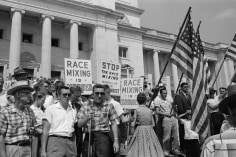
A group of people, several holding signs and American flags, protesting the admission of the "Little Rock Nine" to Central High School, Little Rock, Arkansas, 1959 (Courtesy Library of Congress).
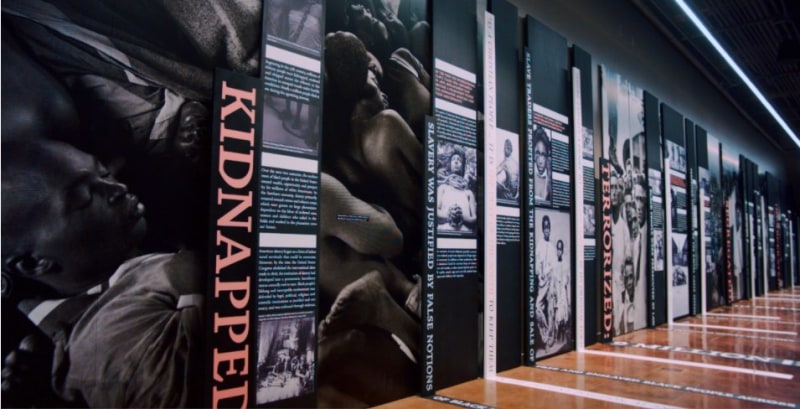
Human Pictures
Essential Question: How has the narrative of racial difference perpetuated the systemic racial injustices of enslavement, lynching and racial terror, segregation, and mass incarceration in the United States?
The narrative of racial difference - the false belief that black people are inherently inferior - has continued to haunt the United States. This narrative of racial difference was created to justify slavery and has survived beyond slavery’s formal abolition, turning into decades of racial terror and segregation. It continues to perpetuate racial inequality today in public policy, the law, the criminal justice system, education, and in many other aspects of culture and society.
To deepen their understanding of this lesson’s essential question, students will engage with multiple source materials including documentary film clips from True Justice: Bryan Stevenson’s Fight for Equality and excerpts from reports published by EJI. Students will synthesize their learning by choosing one form of a narrative map that will express and explain their understanding of the narrative of racial difference.
Students will:
*Understand how the narrative of racial difference was used to justify the systems of enslavement, racial terror lynching, and segregation, and how it continues to sustain racial injustice in our present crisis of mass incarceration
*View segments from True Justice to analyze the narrative of racial difference
*Use information and ideas from the Interview Archive and historical primary source documents to deepen understanding about each of these periods in our nation’s history
*Create a narrative map to summarize their understanding of the narrative of racial difference
Teacher Note: This lesson focuses on the evolution and consequences of the narrative of racial difference in the United States. For more information about the history itself, the Equal Justice Initiative has published multiple in-depth reports on slavery, racial terror lynching, and mass incarceration.
Materials: Equipment for viewing film clips and interview threads, and copies of all handouts from the "Resources" section as needed.
Length: One to two 50-minute class periods plus homework
Read aloud and discuss this Bryan Stevenson quote from True Justice:
"Slave owners in the American South wanted to feel like they were moral people. They were Christians. And to feel that and still be owning other people, they had to say that black people are different than white people. And that was ratified by the Supreme Court in the Dred Scott decision. The Supreme Court says in 1857, look, black people are an inferior race. They’re not like white people. They’re three-fifths human, and because of that, they’re not citizens. They are not protected by the Constitution. And that decision not only allowed slavery to persist, but it created a racial hierarchy. It introduced formally in the law this idea of white supremacy—this narrative of racial difference."
As a class, students will use the context offered by the quote to brainstorm what they believe to be the meaning of the phrase “Narrative of Racial Difference.”
Write the class definition up on the board to refer back to during the class period.
Teacher Note: The following film clips chronicle the through-line of how the narrative of racial difference has influenced enslavement, lynching and racial terror, segregation, and mass incarceration. This content is emotionally difficult and setting the context is critical.
Distribute Handout One: Reckoning With the Narrative of Racial Difference Note Catcher. Ask students to review the Note Catcher before watching the clips so they are familiar with the questions. Invite students to write down their notes while watching, and offer a few minutes after each clip to complete their notes.
Watch Clip 1: "Everybody was Complicit" (runtime 4 min)
In this clip, Bryan Stevenson describes racial terror lynchings and how they were used to terrorize the African American population in order to enforce racial inequality and segregation.
Watch Clip 2: "The Label ‘Slave’ is Replaced with the Label ‘Criminal’" (runtime 4:08)
This clip demonstrates how the criminal justice system became a tool to maintain racial hierarchy and control after slavery was abolished. It draws a historical through-line from the laws that passed during and after Reconstruction to limit the freedom of African Americans, to Civil Rights activists who were criminalized and jailed, to the “tough on crime” laws that initiated and continue to sustain mass incarceration.
Distribute Handouts Two, Three, and Four to delve deeper into how the narrative of racial difference has shaped, and continues to shape American history. These Handouts, and the accompanying instructions and discussion prompts, may also be used as homework.
Handout Two: Racial Terror Lynchings. Using an excerpt from EJI’s “Lynching in America” report, students will gain background knowledge on the context and characteristics of racial terror lynchings. While racial terror lynchings preceded the Civil War, the excerpts chosen discuss the characteristics of racial terror lynchings in the period after the Civil War.
Handout Three: The Legacy of Racial Terror Lynching, Excerpt from “Lynching in America”
Using an excerpt from EJI’s “Lynching in America” report, students will analyze the connection between lynching and capital punishment.
Handout Four: Analyzing Images to Confront Complicity
The acts of racial terror that characterize the periods of enslavement, racial terror lynching, Jim Crow, and mass incarceration are enabled by the narrative of racial difference in that the belief that people of color are inferior to white people enables bystanders to these crimes to be complicit, by either actively taking part in enforcing them, or silently standing by and allowing them to happen.
Students will analyze the images in Handout Four, or viewed online in the Images section below, to reflect on the role of complicity in perpetuating the narrative of racial difference.
*How was the narrative of racial difference sustained from slavery to the present era, and what actions and ideas allowed the narrative to continue to shape American culture across generations?
*How do we change societal narratives, including narratives of racial difference, that perpetuate inequality?
Option One: Ida B. Wells
Ida B. Wells, renowned activist and journalist, played a critically important role in exposing thousands of racial terror lynchings to a national audience and mobilizing protests against these crimes. In 1909, Ms. Wells gave a speech to the National Negro Conference, precursor to the National Association for the Advancement of Colored People (NAACP), entitled “Lynching Our National Crime” in which she said:
The lynching record for a quarter of a century merits the thoughtful study of the American people. It presents three salient facts: First, lynching is color-line murder. Second, crimes against women is the excuse, not the cause. Third, it is a national crime and requires a national remedy. ... Why is mob murder permitted by a Christian nation?
Read the excerpt of her speech included in Handout Six, noting in particular where she refers to the narrative of racial difference. Imagine you were the host of the event where she spoke and write an introduction to this speech that both offers the listeners an explanation of the narrative of racial difference, and insight into how our beliefs about race would change as a result of her recommendations for bringing an end to racial terror lynching.
Option Two: Implicit Bias
In his interview, EJI Deputy Director Randy Susskind says, “Everyone knows that there's implicit bias, that people have deep-seated biases, unconscious biases, and it permeates all areas of life, it permeates how people buy and sell houses, how people get taxi cabs in the city - medical care is affected by that.”
There is a great deal of research and resources available to learn about the effects of implicit bias and how to interrupt and challenge when biases surface. Consider having students learn more about implicit bias from these sources:
● Listen to this Equal Justice Initiative talk on implicit bias and education
● Explore Dr. Jennifer Ebherhardt’s work and research on implicit bias

A group of people, several holding signs and American flags, protesting the admission of the "Little Rock Nine" to Central High School, Little Rock, Arkansas, 1959 (Courtesy Library of Congress).
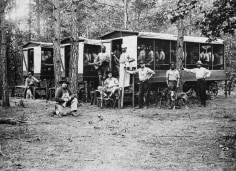
Convict wagons used to transport and house African Americans compelled to work in road gangs, lumber camps, and farms, Pitt County, North Carolina, 1910 (Courtesy Library of Congress).
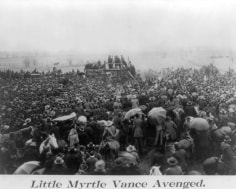
Spectacle terror lynching of Henry Smith in Paris, Texas,1893 (Courtesy Library of Congress).
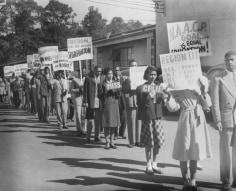
NAACP youth and student members marching with signs protesting Texas segregation laws, Houston, Texas, 1947. (Courtesy Library of Congress).
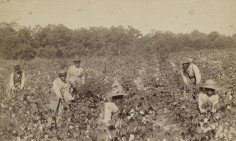
Tenant farmers picking cotton, Savannah, Georgia,1880s (Courtesy Library of Congress).
Building a Narrative Map
Bryan Stevenson and the Equal Justice Initiative believe that throughout history, false narratives have helped to create and sustain injustice, and that it is necessary to confront and change these narratives in order to create a more just society.
To engage students in the process of building a new narrative, each lesson culminates by having students synthesize their learning and map out this information into a form of their choosing. In Lesson Six students will compile these new narrative maps to complete a final assessment.
Distribute Handout Five
For Lesson Two - Narrative of Racial Difference: Organize your learning to reflect your understanding of how the narrative of racial difference has functioned to maintain and perpetuate racial injustice in the United States.
Here are some suggested narrative maps:
Storyboard - A sequence of drawings, typically with some directions and dialogue - that conveys their understanding of the lesson topic.
Graphic Organizer - A relational way to present information in both a visual and text format
Sketchnotes - Often referred to as doodling, sketchnoting is defined as creative, individualized note taking that uses a mix of words and pictures together to create a personal story or narrative
Anchor Standards
Reading Literature and/or Information: Integration of Knowledge and Ideas.
RL/RI.X.7. Integrate and evaluate content presented in diverse media and formats, including visually and quantitatively, as well as in words.
RL/RI.X.8. Delineate and evaluate the argument and specific claims in a text, including the validity of the reasoning as well as the relevance and sufficiency of the evidence.
RL/RI.X.9. Analyze how two or more texts address similar themes or topics in order to build knowledge or to compare the approaches the authors take.
Speaking and Listening: Comprehension and Collaboration
SL.X.1 Prepare for and participate effectively in a range of conversations and collaborations with diverse partners, building on others’ ideas and expressing their own clearly and persuasively.
SL.X.2. Integrate and evaluate information presented in diverse media and formats, including visually, quantitatively, and orally
SL.X.3 Evaluate a speaker’s point of view, reasoning, and use of evidence and rhetoric.
SL.X.5 Make strategic use of digital media and visual displays of data to express information and enhance understanding of presentations.
Writing: Research to Build and Present Knowledge
W.X.7: Conduct short as well as more sustained research projects based on focused questions, demonstrating understanding of the subject under investigation.
W.X.8 Gather relevant information from multiple print and digital sources, assess the credibility and accuracy of each source, and integrate the information while avoiding plagiarism.
